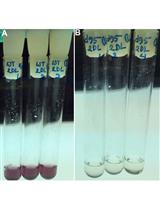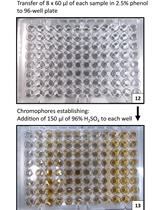- Submit a Protocol
- Receive Our Alerts
- Log in
- /
- Sign up
- My Bio Page
- Edit My Profile
- Change Password
- Log Out
- EN
- EN - English
- CN - 中文
- Protocols
- Articles and Issues
- For Authors
- About
- Become a Reviewer
- EN - English
- CN - 中文
- Home
- Protocols
- Articles and Issues
- For Authors
- About
- Become a Reviewer
Analysis of Mouse Liver Glycogen Content
Published: Vol 2, Iss 10, May 20, 2012 DOI: 10.21769/BioProtoc.186 Views: 40440

Protocol Collections
Comprehensive collections of detailed, peer-reviewed protocols focusing on specific topics
Related protocols

Glycogen and Extracellular Glucose Estimation from Cyanobacteria Synechocystis sp. PCC 6803
Md. Rezaul Islam Khan [...] Gang Ma
May 5, 2018 7062 Views

Determination of Storage (Starch/Glycogen) and Total Saccharides Content in Algae and Cyanobacteria by a Phenol-Sulfuric Acid Method
Tomáš Zavřel [...] Jan Červený
Aug 5, 2018 12549 Views
Abstract
Liver is the major site for glycogen storage. Glycogen content can be significantly altered upon disruption of glucose homeostasis in metabolic syndromes, such as diabetes. Glycogen content can be determined by an acid-hydrolysis method (Passonneau and Lauderdale, 1974). Basically, glucose, the hydrolysis product of glycogen, is converted into glucose-6-phosphate (G-6-P) by hexokinase in the presence of ATP. With the supply of NADP, G-6-P is further converted into 6-phosphogluconic acid by G-6-P dehydrogenase (G-6-PDH), while production of NADPH can be measured spectrophotometrically. Our lab has used this method to demonstrate that liver glycogen levels are significantly elevated in diabetic Perk knockout mice (Zhang et al., 2002).
Materials and Reagents
- Hydrochloric acid (Sigma-Aldrich, catalog number: 653799 )
- Sodium hydroxide
- Glucose (HK) assay reagent (Sigma-Aldrich, catalog number: G2020 )
- Beta-D(+)-glucose (Sigma-Aldrich, catalog number: G5767 )
- ddH2O
- Liquid nitrogen
- 2.0 M HCl
- 2.0 M NaOH
Equipment
- Centrifuges (Eppendorf, Model 5415D )
- Cryogenic vials (Thermo Fisher Scientific, catalog number: 5000-0012 )
- 2 ml Eppendorf tube with locking lid (Thermo Fisher Scientific, catalog number: 02-681-299 )
- Spectra Max 384 spectrophotometer (Molecular Devices)
- Balance
- Quartz cuvette
- Scissors
Procedure
- Liver sample preparation
- Sacrifice non-fasted animals and isolate liver slices. Transfer samples into cryogenic vials, flash-frozen in liquid nitrogen, and stored at -80 °C before use.
Notes:- Collect liver samples in the afternoon or during night when animals are well fed.
- Try to collect samples from around the same region (I typically used the right liver lobe).
- Record the growth and nutrition status of study subjects (body weight, water consumption, etc).
- Use the frozen samples within a month (I have never addressed whether degradation of glycogen could occur during long-term storage).
- Collect liver samples in the afternoon or during night when animals are well fed.
- For each single sample, prepare 0.5 ml of 2.0 M HCl in a 2 ml Eppendorf tube with locking lid. As the control to measure free glucose, substitute 2.0 M HCl with 2.0 M NaOH. Prepare and label enough tubes with either HCl or NaOH.
- Heat the tubes in boiling water for ~ 3 to 5 min.
- Centrifuge briefly, and then wipe the tubes and measure the weights on an analytical balance.
- Prepare frozen liver samples on dry ice. Transfer ~10 mg to 20 mg samples into the above tubes with hot HCl or NaOH. Measure the weights again on balance.
- Seal the tubes tightly and boil the samples in water for 1 h. To achieve complete hydrolysis, mince the liver samples within ~5 min with a scissors, and then shake the tubes vigorously every 10 min during the whole process.
- Cool samples on bench to room temperature (RT) and centrifuge briefly. Reconstitute original weights by adding ddH2O.
- Neutralize the hydrolysis products with 0.5 ml of 2.0 M NaOH or HCl, accordingly.
- Vortex samples vigorously and then centrifuge at maximum speed (i.e., ~ 22,000 x g) for 10 min.
- Sacrifice non-fasted animals and isolate liver slices. Transfer samples into cryogenic vials, flash-frozen in liquid nitrogen, and stored at -80 °C before use.
- Glucose level determination - Glucose concentration of the hydrolysis product can be determined using the Glucose (HK) assay reagent.
- Reconstitute assay reagent with 20 ml ddH2O, and use this reagent within two months.
- For each single sample, prepare 1 ml assay reagent in an Eppendorf tube, and then add 10 μl supernatant of hydrolysis product. Meanwhile, use 10 μl freshly prepared 0.5 mM beta-D(+)-glucose as the standard, and 10 μl ddH2O as the blank.
- Incubated at RT for 5 min.
- Measure absorbance at 340 nm on a Spectra Max 384 spectrophotometer, using a Quartz cuvette.
- Reconstitute assay reagent with 20 ml ddH2O, and use this reagent within two months.
- Liver glycogen content is determined as:
Abs (sample)/Abs (standard) x Concentration (standard) (i.e., 0.5 mM) x Volume (standard) (i.e., 0.01 ml) x Total volume (i.e., 1.0 ml)/Volume (sample) (i.e., 0.01 ml)/ Weight (sample) (mg) x 1000
Unit = micromoles glucosyl units/ per gram wet liver weight.
Notes
Please note that gender, age, genetic background, and particularly, feeding status, which can be affected by housing light-dark cycle, can affect glycogen levels in the liver. Animals fed ad libitum should be used for this type of experiment.
Recipes
- 2.0 M HCl
- 2.0 M NaOH
- Glucose (HK) assay reagent
Acknowledgments
This protocol was adapted from the previously described work of Passonneau and Lauderdale (Passonneau and Lauderdale, 1974). PZ was supported by a research assistantship in the Cavener lab at the Pennsylvania State University. This work was supported by an NIH R01 grant awarded to DC.
References
- Passonneau, J. V. and Lauderdale, V. R. (1974). A comparison of three methods of glycogen measurement in tissues. Anal Biochem 60(2): 405-412.
- Zhang, P., McGrath, B., Li, S., Frank, A., Zambito, F., Reinert, J., Gannon, M., Ma, K., McNaughton, K. and Cavener, D. R. (2002). The PERK eukaryotic initiation factor 2 alpha kinase is required for the development of the skeletal system, postnatal growth, and the function and viability of the pancreas. Mol Cell Biol 22(11): 3864-3874.
Article Information
Copyright
© 2012 The Authors; exclusive licensee Bio-protocol LLC.
How to cite
Zhang, P. (2012). Analysis of Mouse Liver Glycogen Content. Bio-protocol 2(10): e186. DOI: 10.21769/BioProtoc.186.
Category
Biochemistry > Carbohydrate > Glycogen
Do you have any questions about this protocol?
Post your question to gather feedback from the community. We will also invite the authors of this article to respond.
Share
Bluesky
X
Copy link









